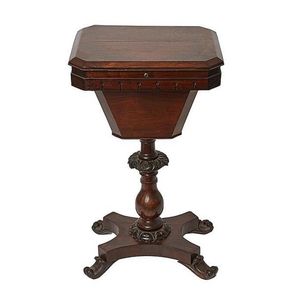Australian Cedar Card Table, Andrew Lenehan, Circa 1845
You must be a subscriber, and be logged in to view price and dealer details.
Subscribe Now to view actual auction price for this item
When you subscribe, you have the option of setting the currency in which to display prices to $Au, $US, $NZ or Stg.
- Circa - A Latin term meaning 'about', often used in the antique trade to give an approximate date for the piece, usually considered to be five years on either side of the circa year. Thus, circa 1900 means the piece was made about 1900, probably between 1895 and 1905. The expression is sometimes abbreviated to c.1900.
- Column - An architectural feature sometimes used for decorative effect and sometimes as part of the supporting construction. Columns should generally taper slightly towards the top. They may be plain or decorated with carving, fluting or reeding. Columns may be fully rounded or, more commonly, half-rounded and attached with glue, screws or pins to the outer stiles of doors, or the facing uprights on cabinets and bureaux.
- Baize - Baize is a type of fabric that is made from wool or a wool blend. It is a dense, closely-woven fabric that is smooth to the touch and has a matte finish. Baize is often used for covering surfaces, such as table tops or the playing surface of card, pool and billiard tables, and for lining drawers and boxes, because it is durable and resistant to wear. This fabric is often associated with gambling and is often used on casino gaming tables and other gaming equipment.
- Frieze - An architectural term denoting the flat, shaped or convex horizontal surface of furniture, between the architrave and the cornice, usually found on a cabinet or bookcase, or on desks and tables where it may include drawers, the area between the top and the legs. In ceramics, the term refers to the banding, of usually a repeating pattern, on the rims of plates and vases.
- Provenance - A term used to describe the provable history of an antique or work of art, and thus an additional aid to verifying its authenticity. Provenance can have an inflating effect on the price of an item, particularly if the provenance relates to the early settlement of Australia, a famous person, or royalty. Less significant are previous sales of the item through an auction house or dealer.
- Castors - Wheels, fitted especially to chair legs, couches, tables and some smaller pieces of furniture, to enable them to be easily moved about. The earliest castors were of brass, with shanks fitting into the base of the leg, and the wheels often made of leather. In the late 18th century, brass 'bucket' or 'cup' castors were introduced, either rounded or square, fitting directly over the end of the leg and held in place with screws. The wheels were generally solid brass. Bucket/cup castors continued in use throughout the 19th century and indeed are still made today. In the later 19th century wheels were sometimes made of wood, china, either white or brown, and sometimes of steel.
- Paw Feet - A paw foot is a base of a furniture leg that resembles the paw of an animal, such as a lion or bear. It is a decorative feature that is often seen in traditional furniture designs, particularly in styles such as Chippendale, Queen Anne, and Georgian. A paw foot typically consists of a carved or moulded ball or disk at the bottom of the leg, which is then carved or shaped to resemble the toes or claws of an animal. The foot may be smooth or textured, depending on the design, and may be finished in a variety of materials, such as wood, metal, or even marble.
Paw feet are often used on heavier pieces of furniture, such as chests, tables, and chairs, to provide additional stability and support. They are also used as a decorative element, adding a touch of elegance and sophistication to the overall design.
"Hairy paw feet" is a term used to describe a variation of the foot design that features a carved or sculpted animal paw, such as a lion or bear, with hair or fur details. The hair or fur details were often carved in a realistic manner and added to the overall decorative effect of the furniture. Hairy paw feet were commonly found on furniture items such as tables, chairs, and cabinets and were popular in the 18th century.
This item has been included into following indexes:
Visually similar items

A William IV fold over mahogany games table, circa 1830, the squared table with a circular baize interior upon a faceted pedestal to a circular boss with fine upward scrolling feet. Height 74 cm. Length 92 cm. Width 45 cm. Extended length 91 cm

Early Victorian Brazilian rosewood sofa table circa 1840, lacking one piece of applied moulding to apron, 71 cm height, 130 cm length, 57 cm depth

A William IV-style figured mahogany occasional table, in the form of a work table, the rectangular top with serpentine edge above two drawers, raised on a turned pedestal and concave-sided platform base with scrolling feet. Height 72 cm length 47 cm. Width

A Victorian mahogany sewing table, with carved pedestal and platform base with four scroll feet.
